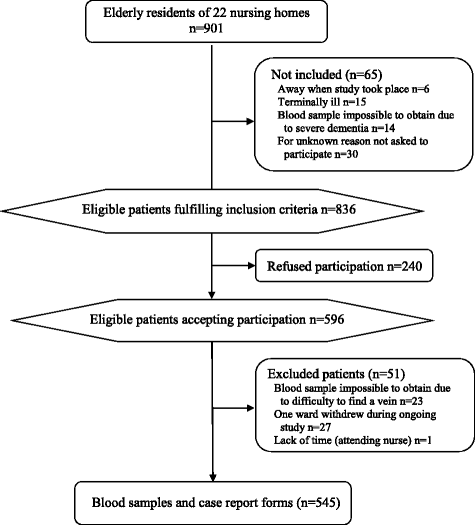Vitamin D deficiency was common among nursing home residents and associated with dementia: a cross sectional study of 545 Swedish nursing home residents
- PMID: 29017462
- PMCID: PMC5634897
- DOI: 10.1186/s12877-017-0622-1
Vitamin D deficiency was common among nursing home residents and associated with dementia: a cross sectional study of 545 Swedish nursing home residents
Abstract
Background: Residents of nursing homes may have low 25-hydroxyvitamin D (25OHD) concentrations. Associations between vitamin D and cognitive performance, dementia and susceptibility to infections are not clearly established. The aim of this study was to investigate the prevalence of vitamin D deficiency and to identify associated factors among residents of nursing homes for elderly.
Methods: In this cross-sectional study blood samples for analysis of 25OHD were collected from all participating residents of Swedish nursing homes for the elderly from January to March 2012.
Exclusion criteria: dementia too severe to collect a blood test, terminally ill or refusing participation.
Outcome measures: Serum 25OHD concentrations. Logistic regression to evaluate factors associated with vitamin D deficiency (25OHD < 25 nmol/L).
Results: Blood samples were obtained from 545 of 901 residents of 22 nursing homes. Mean age 86 years (SD 6.9), 68% were women. Prevalence of vitamin D supplementation 17%, dementia 55%, lack of appetite ≥3 months 45% and any antibiotic treatment during the last 6 months 30%. Serum 25OHD concentrations: mean 34 nmol/L (SD 21, median 27, range 4-125), 82% (448/545) had 25OHD < 50 nmol/L and 41% (224/545) had 25OHD < 25 nmol/L. Adjusted OR (95% CI; p-value) for possible predictors of vitamin D deficiency (25OHD < 25 nmol/L): vitamin D supplementation 0.075 (0.031-0.18; p < 0.001), lack of appetite ≥3 months 0.75 (0.50-1.1; p = 0.15), hours outdoors/week 0.99 (0.96-1.0; p = 0.62), Fitzpatrick skin phototype (4-6) 0.69 (0.44-1.1; p = 0.12); dementia 2.3 (1.5-3.4; p < 0.001) and antibiotics last 6 months 1.6 (1.1-2.6; p < 0.029), adjusted for age and gender.
Conclusions: Vitamin D deficiency was common among nursing home residents and strongly associated with dementia. Regardless of causality or not, it is important to be alert for vitamin D deficiency in nursing homes residents with dementia. As expected vitamin D supplementation was associated with less vitamin D deficiency, however lack of appetite, staying outdoors and skin phototype were not significant predictors. Antibiotic treatments during the last 6 months were associated with vitamin D deficiency, potentially supporting the hypothesis that vitamin D deficiency is associated with infections.
Keywords: Antibiotics; Dementia; Frail elderly; Homes for the aged; Infectious disease; Nursing homes; Vitamin D.
Conflict of interest statement
Ethics approval and consent to participate
The study was approved by the Regional ethical review board of Gothenburg University (D-nr 578–11). All residents were informed of the study both verbally and in writing. From decision-capable individuals choosing to participate in the study, informed approval was collected. However, a considerable number of participants consisted of residents with dementia of varying degrees. If the resident was incapable of understanding the given information and thereby possessing a reduced decision capability, these residents only participated so long as they both: Did not oppose participation in the study and that the appointed representatives or relatives did not oppose their participation after being provided with information about the study. The Regional ethical review board of Gothenburg University approved this procedure.
Consent for publication
Not applicable.
Competing interests
The authors declare that they have no competing interests.
Publisher’s Note
Springer Nature remains neutral with regard to jurisdictional claims in published maps and institutional affiliations.
Similar articles
-
Vitamin D deficiency in nursing home residents: a systematic review.Nutr Rev. 2023 Jun 9;81(7):804-822. doi: 10.1093/nutrit/nuac091. Nutr Rev. 2023. PMID: 36367832 Free PMC article.
-
Bacteriuria and vitamin D deficiency: a cross sectional study of 385 nursing home residents.BMC Geriatr. 2019 Dec 30;19(1):381. doi: 10.1186/s12877-019-1400-z. BMC Geriatr. 2019. PMID: 31888514 Free PMC article.
-
Seasonal prevalence of vitamin D deficiency in institutionalized older adults.J Am Geriatr Soc. 1997 May;45(5):598-603. doi: 10.1111/j.1532-5415.1997.tb03094.x. J Am Geriatr Soc. 1997. PMID: 9158582
-
Effectiveness and safety of a high-dose weekly vitamin D (20,000 IU) protocol in older adults living in residential care.J Am Geriatr Soc. 2014 Aug;62(8):1546-50. doi: 10.1111/jgs.12927. Epub 2014 Jul 15. J Am Geriatr Soc. 2014. PMID: 25039913
-
Vitamin D insufficiency: Definition, diagnosis and management.Best Pract Res Clin Endocrinol Metab. 2018 Oct;32(5):669-684. doi: 10.1016/j.beem.2018.09.014. Epub 2018 Oct 3. Best Pract Res Clin Endocrinol Metab. 2018. PMID: 30449548 Review.
Cited by
-
No Significant Association between 25-OH Vitamin D Status and SARS-CoV-2 Antibody Response after COVID-19 Vaccination in Nursing Home Residents and Staff.Vaccines (Basel). 2023 Aug 8;11(8):1343. doi: 10.3390/vaccines11081343. Vaccines (Basel). 2023. PMID: 37631911 Free PMC article.
-
Beneficial Effects of Oral Nutrition Supplements on the Nutritional Status and Physical Performance of Older Nursing Home Residents at Risk of Malnutrition.Nutrients. 2023 Oct 8;15(19):4291. doi: 10.3390/nu15194291. Nutrients. 2023. PMID: 37836574 Free PMC article. Clinical Trial.
-
Vitamin D deficiency in nursing home residents: a systematic review.Nutr Rev. 2023 Jun 9;81(7):804-822. doi: 10.1093/nutrit/nuac091. Nutr Rev. 2023. PMID: 36367832 Free PMC article.
-
Vitamin D Status and Physical Functioning in Nursing Home Residents after Improved Adherence to the Vitamin D and Calcium Recommendation-A Quasiexperimental Study.J Nutr Metab. 2024 Oct 5;2024:2405429. doi: 10.1155/2024/2405429. eCollection 2024. J Nutr Metab. 2024. PMID: 39398329 Free PMC article.
-
Mothers' knowledge, practice, and attitudes toward vitamin D deficiency among children in the Qassim region, Kingdom of Saudi Arabia.J Med Life. 2022 Sep;15(9):1100-1104. doi: 10.25122/jml-2021-0384. J Med Life. 2022. PMID: 36415522 Free PMC article.
References
-
- Burgaz A, Akesson A, Oster A, Michaelsson K, Wolk A. Associations of diet, supplement use, and ultraviolet B radiation exposure with vitamin D status in Swedish women during winter. Am J Clin Nutr. 2007;86(5):1399–1404. - PubMed
-
- Holick MF. Environmental factors that influence the cutaneous production of vitamin D. Am J Clin Nutr. 1995;61(Suppl 3):638s–645s. - PubMed
MeSH terms
Substances
LinkOut - more resources
Full Text Sources
Other Literature Sources
Medical
Research Materials


